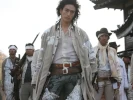Eye For Film >> Movies >> Sukiyaki Western Django (2007) Film Review
Sukiyaki Western Django
Reviewed by: Jennie Kermode

A stranger rides into a lonely desert town. He’s wearing a long coat and a hat. He doesn’t give his name. When he reaches the central street, he finds two gangs, the Reds and the Whites, facing off against each other. He shifts his coat, revealing his pistol.
“Best not get any ideas about playing Yojimbo,” says the leader of the Reds.

Among the most successful of all modern legends, Yojimbo/Django has spawned more than 30 iterations in film. Takashi Miike’s film – itself now adapted into a manga – is at once the most heavily referential and a highly distinctive version – you will not, as with some of the others, be at risk of forgetting which one you’re watching. This is only in part due to the use of a mostly Japanese cast speaking (with varying degrees of success) in English. Resembling some of the legendary director’s most outré works like The Happiness Of The Katakuris and The Mole Song: Final in its intense stylisation and frenetic pace, it’s a film that some viewers will find utterly unwatchable, but for others it’s a treat.
The first things likely to catch you eye are the gorgeous costumes by Michiko Kitamura, who also worked with Miike on Ichi The Killer. There’s a lot going on with these, as they play with styles from different eras (the film is set, with wonderful vagueness, ‘several hundred years after the battle of Dannoura’). They also introduce a comic book aesthetic, make reference to previous versions of the Django story, and combine in ways that give the director even more opportunity for visual play during the battle scenes. There are many such scenes, and they are delivered with his usual verve, mixing and matching gunplay and samurai swordplay while also making use of the wider environment. As it turns out, this small town contains several legendary fighters, each with a distinctive style. We also get Quentin Tarantino, clearly in full-on fanboy mode, as a blend of storyteller and sensei.
Alongside war, there is also love. One of the lovers is dead at the start, having made enemies by marrying a woman from the other side. His beautiful widow, Shizuka (Yoshino Kimura) has become the lover of the leader of the Whites, performing for his pleasure the sort of dance that drove Uther Pendragon to madness in Excalibur, willing to put up with anything if she can get revenge. Her young son Heihachi, however, tends the blended red and white roses that the couple grew together, and is cared for by his grandmother Ruriko (Kaori Momoi), who hopes to shelter him from the violence until he’s ready to pursue a destiny of his own. Naturally, she too has a secret.
Those roses are just one of multiple references to England’s War of the Roses, the most blatant being the decision by the leader of the Reds, who is obsessed with Shakespeare, to rename himself Henry. There are also multiple references to the Genpei War, which has often been described as Japan’s equivalent. The most notable feature of both, of course, is that almost everyone who was anyone died. This film may seem to have surfeit of characters, causing confusion early on, but they are mostly there to allow Miike to illustrate something similar, in increasingly elaborate ways. With arrows, in particular, Miike keeps one-upping himself, aided by his trademark commitment to going all the way with action sequences no matter how silly they may become.
All the classic Django motifs are here, from the coffin-carried Gatling gun to the final song, but even if you’re familiar with the beats, you’ll enjoy plenty of surprises. The film is very full on, however, rarely giving viewers time to breathe, and this doesn’t always work in its favour. Scenes whose diligent construction one can appreciate on a second watch too often come across as just chaotic, which may deter viewers from completing a first watch. Others will find that the film is best consumed in 15 minute segments. However you go about it, there is plenty to admire in Miike’s craft, and the sum of his talents is something altogether unique.
Reviewed on: 22 Jun 2025

















